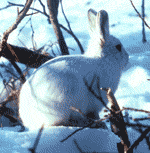 The Arctic Hare (Lepus arcticus) was once considered a subspecies of the Mountain Hare; however it is now known to be its own species of hare. The Arctic Hare is highly adapted to colder climates and thrives in the polar and mountainous regions of the northern hemisphere with smaller ears and very dense fur. Its distribution is wide as it lives in the cold and icy tundra of Canada, Greenland, and Alaska, and there are four subspecies known. Those that live in the farthest northern reaches are white all year long – while those that live in more temperate locations will change color from white to a grayish blue in summer while maintaining the snow-white tail. They can grow to a size of around 28 inches (70cm) in length, and can weigh as much as 12 lbs (5.5kg). Their diet consists of woody plant material, along with berries, buds, leaves, and greases. It can find these even under the snow using its well developed sense of smell and its digging prowess.
The Arctic Hare (Lepus arcticus) was once considered a subspecies of the Mountain Hare; however it is now known to be its own species of hare. The Arctic Hare is highly adapted to colder climates and thrives in the polar and mountainous regions of the northern hemisphere with smaller ears and very dense fur. Its distribution is wide as it lives in the cold and icy tundra of Canada, Greenland, and Alaska, and there are four subspecies known. Those that live in the farthest northern reaches are white all year long – while those that live in more temperate locations will change color from white to a grayish blue in summer while maintaining the snow-white tail. They can grow to a size of around 28 inches (70cm) in length, and can weigh as much as 12 lbs (5.5kg). Their diet consists of woody plant material, along with berries, buds, leaves, and greases. It can find these even under the snow using its well developed sense of smell and its digging prowess. The Arctic Hare does not hibernate, but will dig a shelter in the snow and huddle with other hares for warmth. If they are threatened by predators they can accelerate in an instant to very high speeds – up past 40 miles per hour (60 km/h) to escape.
The Binomial Name for the Arctic Hare is Lepus arcticus, and it has four subspecies: Lepus arcticus monstrabilis, Lepus arcticus groenlandicus, Lepus arcticus bangsii, and the base species Lepus arcticus arcticus (much like Homo sapiens sapiens). Lepus contains all of the hares and jackrabbits – but most certainly not the rabbits. Hares are generally larger and stronger – and have never been domesticated. Lepus belongs to the Family Leporidae, which does contain the rabbits, and also the pygmy rabbits and many other rabbits which belong to their own genus. Leporidae belongs to the Order Lagomorpha of which there is one other family – the Ochotonidae which contains the Pikas and the extinct Giant Rabbit (Minorcan Giant Lagomorph) which weighed in excess of 50 lbs (23 kg). Lagomorpha belongs to the Superorder Euarchontoglires – however they belong to the Glires, a subset of the Euarchontoglires which also contains the subset Euarchonta (of which we are members). Euarchontoglires belong to the Infraclass Eutheria, the Subclass Theria, and the Class Mammalia.
Fact
The Arctic Hare was an important resource to Native Americans in that they can provide food and clothing with their thick fur. As the species is extremely plentiful it was a lifesaver in many winters when food was scarce, and warmth in high demand.
Keywords: white
The Arctic hare is listed as Least Concern (LR/lc), lowest risk. Does not qualify for a more at risk category. Widespread and abundant taxa are included in this category, on the IUCN Red List of Threatened Species
Namings for the Arctic hare
A young / baby of a Arctic hare is called a 'leveret'. The females are called 'doe or jill' and males 'buck or jack'. A Arctic hare group is called a 'band or down'.Arctic hare habitats
Subarctic forest
Custom Search